What is my Favourite Dinosaur?
Part 3: The Iguanodon
A blog post by Felicity
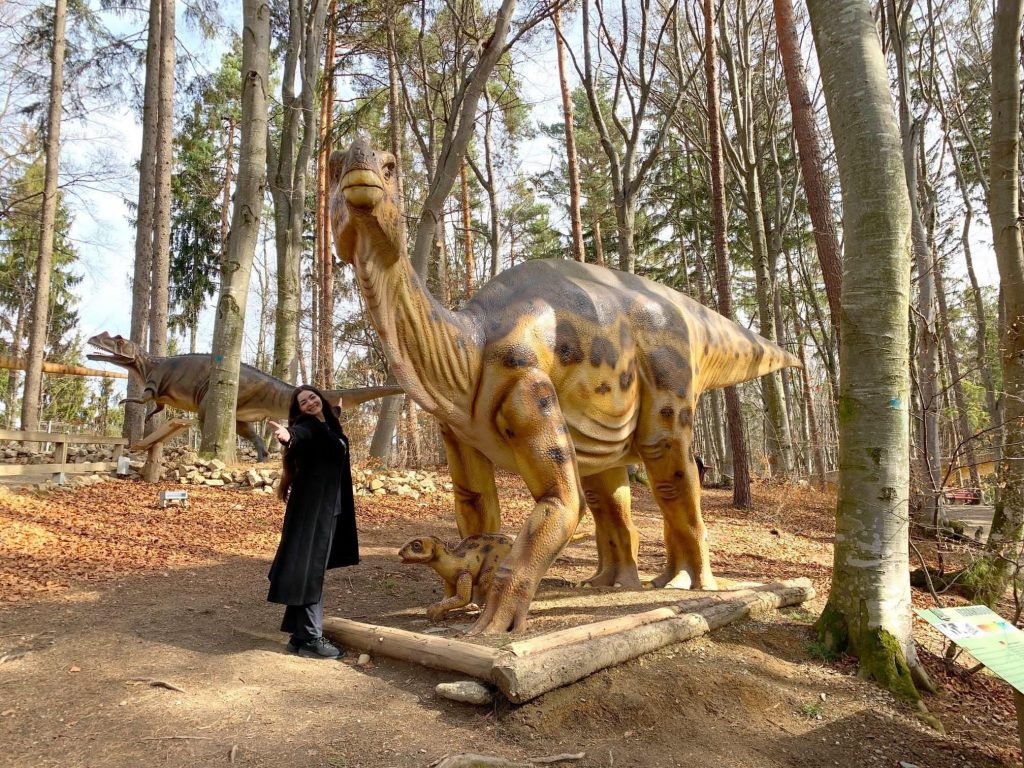
While most people have heard of dinosaurs such as the T-Rex, the Triceratops, the Stegosaurus and one of the long-necked sauropods such as the Brachiosaurus or the Brontosaurus, I would say less than half of the people I ask on my fossil walks have heard of the Iguanodon. Of those who have heard of it, maybe half of them really know what the species looked like, or anything about it aside from its name.
I find this a real shame, as the Iguanodon is such an important species of dinosaur, historically speaking.
The first dinosaur ever named was the Megalosaurus. It was found in Oxfordshire, England and was named ‘Great Lizard’ in 1824. One year later, in 1825, the Iguanodon (‘Iguana Tooth’) was named. Next came the Hylaeosaurus (‘Lizard Belonging to the Forest’), which was discovered in 1832. It was these three dinosaurs that Sir Richard Owen (an English biologist, comparative anatomist and palaeontologist) studied and it was from this study in 1842 that the classification of ‘Dinosauria’ was created.
Let that sink in for a moment. It was thanks to the study of these three discoveries that we even have the term ‘dinosaur’. That, to me, is huge. These dinosaurs should be the most famous species of all. Have you heard of them? Most people haven’t.
The first dinosaur, the Megalosaurus was a carnivore. A complete skeleton of this species has never been found so exactly what this dinosaur looked like is still open for debate but we do know it was a large, bipedal carnivore. Approximately 20 foot long, 1,500 pounds, strong hindlimbs, short forelimbs and a large head filled with curved teeth. A strong, solid, muscular carnivore.
The third dinosaur, the Hylaeosaurus, was a herbivore. This dinosaur was a type of Ankylosaur dinosaur. I talked about these dinosaurs in one of my previous posts (Here) so hopefully you know from that if not from your own love and interest in dinosaurs that the ankylosaurs were the heavily armoured dinosaurs. The most famous being the ankylosaur with its armoured plated body, thorny spiked back and a huge club at the end of the tail. The Hylaeosaurus is known from partial remains so once again our knowledge is limited. It was approximately 16 foot long, armoured and sporting three long spikes/ spines on its shoulder.

I deliberately left the second species, the Iguanodon, to last as that is the focus of this blog post.
The name Iguanodon means ‘Iguana tooth’. The story goes that while Gideon Mantell (an English obstetrician, geologist and Palaeontologist) was visiting a patient in Sussex in 1822, his wife Mary was taking a walk and discovered some fossilised teeth. Knowing of her husbands interest in such things she showed them to him.
Initially others in the field dismissed them as fish teeth or the incisors of a rhinoceros. Further research eventually led Mantell to the Royal College of Surgeons where he endeavoured to find a modern day comparable for these teeth amongst reptilian samples. The assistant curator there realised they resembled those of an Iguana he had recently prepared albeit twenty times longer. This gave the species its name – The Iguana Tooth.
As normal with such discoveries, there was more involved with this than I think it is necessary to go into detail with in this post. Getting the species studied and deciding on a name and getting it accepted and published… there were further specimens discovered in a number of different places and it all starts to paint a picture of what this prehistoric creature was like. It can get a bit confusing and messy when trying to explain it all though.
As more specimens were discovered and as science advanced, so this species and our understanding and perception of it evolved.
Today it is not difficult to find models of dinosaurs. I am not just talking about accurate and detailed examples of dinosaurs and their bones in museums around the world. I am talking about models in fun/ theme park attractions and even on crazy golf courts.
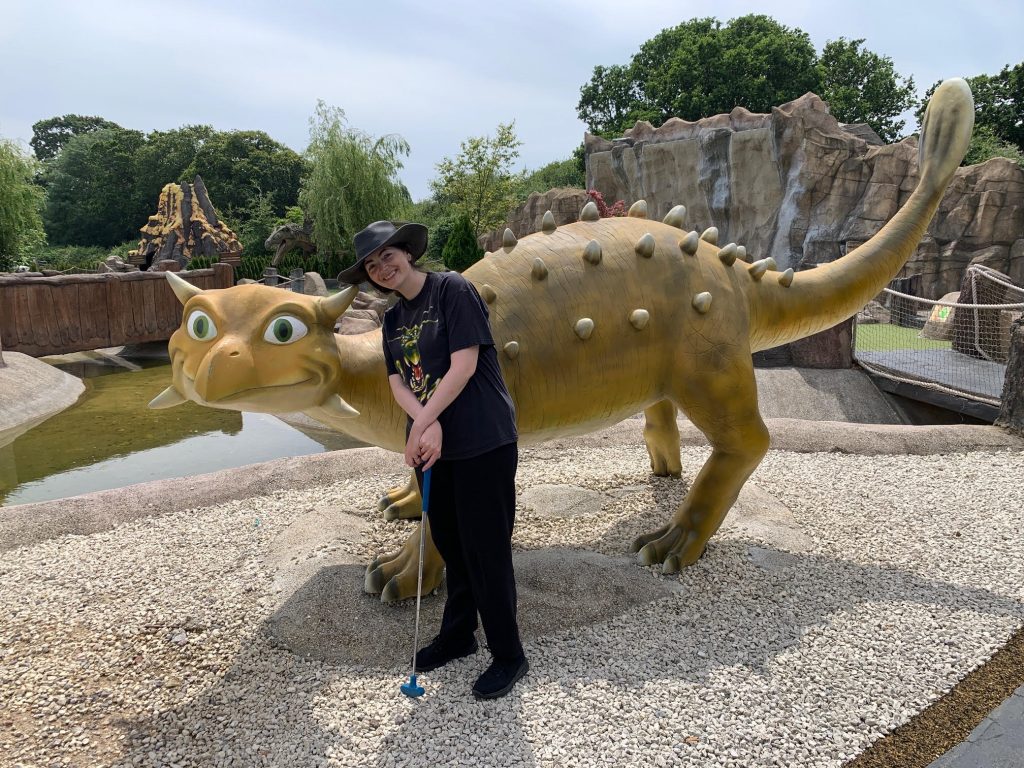
I think most people have had the experience at least once of walking up to a ‘life sized’ dinosaur model and likely posing for a picture too. While it does not seem at all unusual today, this was not always the case. It was actually in 1854 that the first dinosaur sculptures in the world were unveiled.
The Crystal Palace Dinosaurs. A collection of dinosaurs and other extinct animal sculptures displayed to this day in London. Designed and sculpted by Benjamin Waterhouse Hawkins under the scientific direction of Sir Richard Owen. While they are completely outdated and inaccurate by todays standard, they played a huge role in fuelling the general publics interest and love of dinosaurs. Today dinosaurs are everywhere! Walk down a high street as I did this morning and you too will likely see dinosaurs. A dinosaur balloon bobbing jauntily in a card shop window. A child wearing a dinosaur adorned raincoat. A toddler in a pushchair holding onto a cuddly, plush dinosaur toy. Dinosaurs are everywhere. Before the Crystal Palace Dinosaurs, this was far from the case. The discoveries were new and people didn’t really know about dinosaurs. The people that visited this park truthfully didn’t know or accurately learn much about dinosaurs either but you have to start somewhere!
The Iguanodon model in Crystal Palace Park is positioned on four limbs more like an Iguana or a crocodile. A truly reptilian position. It is not hard to guess why- the teeth resembled those of a lizard so why not the rest of the body too?
The reason why this isn’t right, or one of the reasons, is the hips. Dinosaurs have something called upright posture. The position of a dinosaurs hips are beneath the body rather than to the side like modern reptiles. If the Iguanodon was in the same hip position as modern reptiles the creature would have to dig a small trench wherever it went – the hips were too deep to stand as it was depicted. It would be unable to move. The whole thing is just terribly wrong.
Another notable mistake with the model is the horns adorning the head. They found horn like fossils and by looking at modern animals they recognised horns often go on the head. Can’t argue with that either. It was only when more complete fossil remains were found that scientists realised the species had unusually elongated thumb spikes. The size of these creatures was also widely overestimated in the early days – when you only have a few partial remains and you are comparing those partial remains to modern day creatures to give you a ‘best guess’ scenario as to what this prehistoric creature was like… when the tooth you are holding is twenty times bigger than its modern day ‘equivalent’, you’re going to estimate that the prehistoric creature was twenty times bigger also but this was often completely inaccurate. During the construction of one of the Iguanodon models a banquet for twenty people was held inside the dinosaur. Now while in reality the Iguanodon was big, no way was it big enough for that!
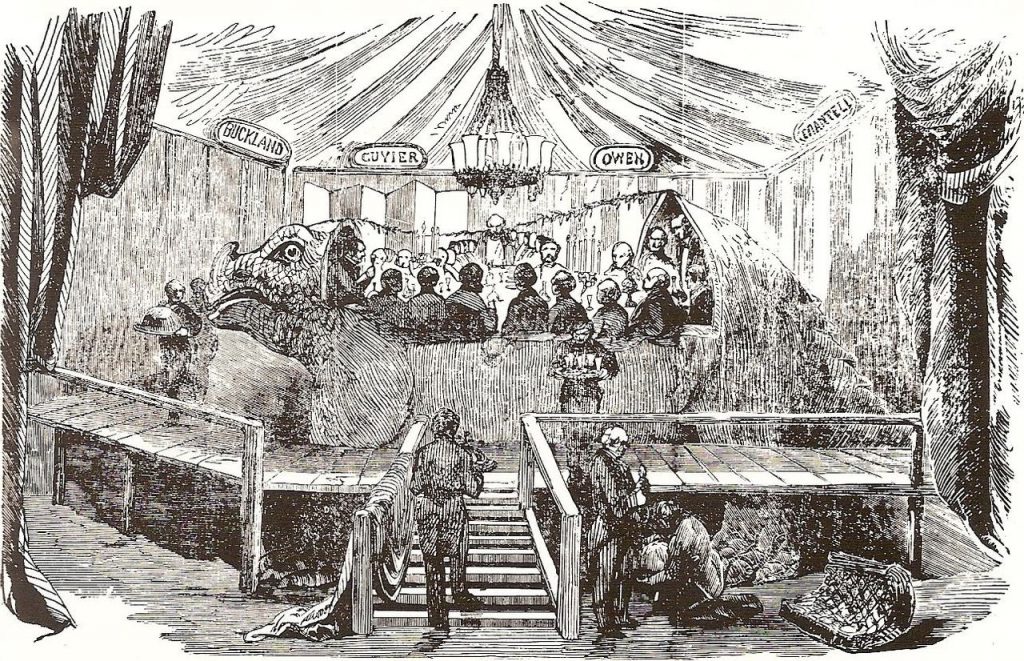
I do often recommend a trip to see the Crystal Palace Dinosaurs to enthusiasts on my dinosaur fossil walks. I think it is an important piece of dinosaur history and a wonderful example of how far people have come in our understanding of the past. Another place I recommend to people is the Dinosaur Museum in Brussels, Belgium.
In 1878 two mine workers in a coal mine in Bernissart accidentally hit a skeleton which they initially mistook for petrified wood. A few months later they began excavating and reconstructing the fossilised bones. At least 38 Iguanodon dinosaurs were uncovered, many of which were adults. These were the most complete specimens of this species found at that time and it was thanks to these that it was realised that the thumb spikes were just that.
In 1882 the holotype specimen became one of the first ever dinosaur skeletons mounted for display. They achieved a lifelike pose by using a series of adjustable ropes attached to scaffolding and the dinosaurs were open for public viewing a year later.
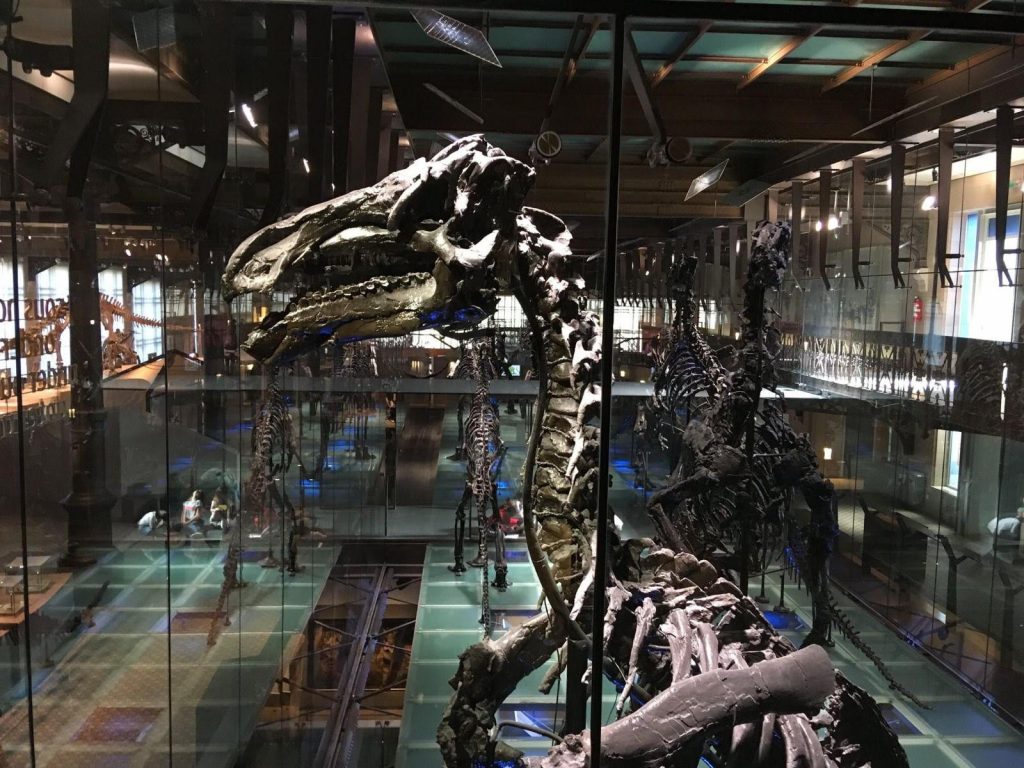
In 1891 this specimen and several others were moved to the Royal Museum of Natural Sciences (part of the Royal Belgian Institute of Natural Sciences) where they can still be admired today. While about nine of them are displayed on standing mounts, about nineteen more are on display in the museums basement showing how the dinosaurs were positioned in the mines upon discovery. When me and Greg visited the Museum a couple of years ago, the display left me speechless (much to the amazement of those who know me!).
I have lived on the Isle of Wight for many years now, and over those years I have amassed a nice little collection of dinosaur bone fragments. Many of these treasures are from the Iguanodon and while I am thrilled every time even the smallest bone fragment is discovered by me or anyone walking with me, it is a completely different thing to stand beside not just one but many near complete Iguanodon fossil skeletons.
I step in their footprints, I stand upon their foot-casts, I hold pieces of their fossilised bones in my hands on a regular basis but I cannot really explain how I truly felt coming face to face with these giants from the past.
I heartily recommend anyone with a love of dinosaurs and of Iguanodon especially to visit this museum in Belgium. You won’t be disappointed! Likelihood is you won’t want to leave come closing time, I know I didn’t! One visit wasn’t enough for me- I fully intend to return for another look one day in the not too distant future. Maybe I will see you there!
One other note that I also really liked about this place : when me and Greg were there, the Iguanodon were mounted on a metal frame. The bones are fossilised so made of stone now. That stone is heavy so the metal frame is very strong and sturdy. The bones were modelled after a kangaroo (or wallaby and a cassowary) in their placement which means the tail runs along the ground. For all of the dinosaur footprints found around the world, to my knowledge, we have never found a tail print. Dinosaur tails were used for balance to offset the weight of the body, they didn’t touch the ground like a kangaroo, but along the way to figuring out dinosaurs and their postures, this is one of the many mistakes people made.
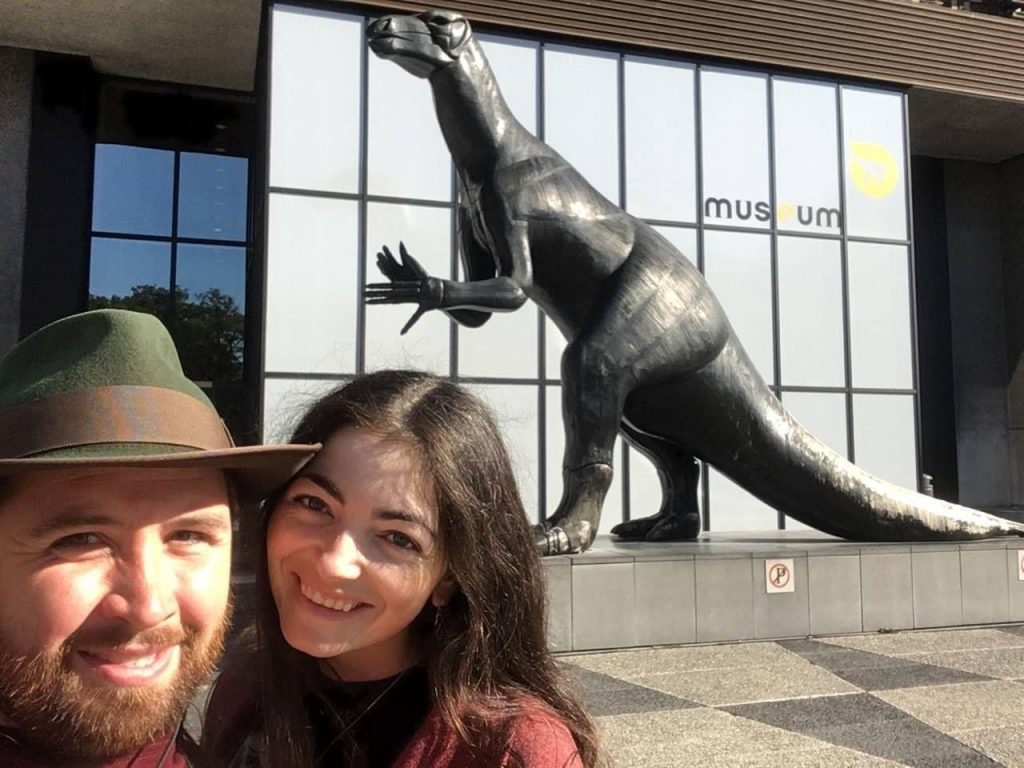
The museum had a sign which explained that while they know it is inaccurate today – in the 1980s palaeontologist David B. Norman figured out the problems with the posture – it was decided that the bones are too fragile and it would therefore be difficult to change it now, so they are leaving it as is.
I found this amusing, but also another nice example of how the species has changed in our perception of it. The less amusing part was that we heard that to position a straight tail with this bend to run along the floor – some of the tail bones would need to be broken or certainly overlapped to achieve this. You would have thought that when constructing them this detail would tell you that you’ve got something wrong but that’s what they did back then!
World Wars and the Great Depression put somewhat of a halt on Iguanodon and dinosaur studies but in 1925 a new species found on the Isle of Wight (in 1914) was named Iguanodon Atherfieldensis.
This sparked off more study and research and then there was the dinosaur renaissance. This is when things started getting really interesting with theories about dinosaurs being warm blooded and related to birds more closely than with modern reptiles which led to dinosaurs completely changing not just in the scientific community but in artists portrayal too. An illustration of the Deinonychus in a lively depiction was one of the first of its kind and has become particularly iconic.
During the 1970s dinosaurs shifted from being the slow moving lizard like beasts to more lively mammal and bird like creatures. Dinosaurs were active, not slow and sluggish and now the media started to reflect this and once again dinosaurs were back to growing in popularity and fame.
The Iguanodon Atherfieldensis was actually renamed to Mantellisaurus in honour of Gideon Mantell. A smaller, more lightly built version of the original Iguanodon. As happens with some species of dinosaur, names get changed and species get reassigned to new groups. The original English ‘Iguanodon’ now have about four species linked to them (one of which being the Mantellisaurus) and the wonderful Belgium specimens are what people look to as Iguanodon (Bernissartensis).
While things kept changing for so many years since the original discoveries, we do now know that Iguanodon were large, quite bulky herbivores. They could shift from bipedal to quadrupedal. They were about 30 feet long and weighed approximately 3.4 tons. They had beak like mouths and teeth like that of the Iguana. Their arms were relatively long and their hands were stiff with the three central fingers able to bear weight. Their most distinctive features would be their large thumb spikes (potentially used to defend themselves from predators or competition amongst members of the same species but also perhaps for foraging) and their long, dextrous fifth fingers which likely helped manipulate and grasp objects when foraging for food.
The legs were strong and their feet had three toes. They had strong, stiff tails that got stiffer as tenons turned to bones over time.
The Iguanodon (and the group ‘Iguanodonts’) were among the first dinosaurs ever to be found and they are among the best known or understood of all the dinosaurs. They were one of the most diverse and widespread of herbivorous dinosaur groups during the cretaceous period. When you consider these facts, I can see why many people would choose Iguanodon as their favourite dinosaur. Hopefully you can also see why I felt it at the very least deserved its own blog post entry.
Thank you for reading,
Felicity
P.S.
Find out about our new documentary (Seeking The First Dinosaur Hunters), and where to watch it, at www.seekingthefirstdinosaurhunters.com.
P.P.S.
If you enjoyed this blog post, please leave a comment and say ‘hello’!
For information on all of our projects, visit: www.gregandfelicityadventures.com
Follow us on Instagram at: https://www.instagram.com/gregandfelicity
Like us on Facebook at: https://www.facebook.com/GregandFelicityAdventures
There are various places you can watch our documentaries and series!
Seeking Cetaceans In Scotland: A two-part documentary about the work of the Cetacean Research and Rescue Unit as they work to help whales, dolphins and porpoises in the Moray Firth in Scotland:
Free in the USA on Tubi TV at:
https://tubitv.com/movies/678018/seeking-cetaceans-in-scotland
Free Worldwide on PlexTV at:
https://watch.plex.tv/movie/seeking-cetaceans-in-scotland
With a library card on the Hoopla service where applicable:
https://www.hoopladigital.com/title/15313766
Free in the USA on Xumo at:
https://www.xumo.tv/channel/99991731/free-documentaries?v=XM00ILOFXCKLUC&p=74071
Buy it without ads Amazon’s Prime Video at:
UK: https://www.amazon.co.uk/dp/B09RVWVFCV
USA: https://www.amazon.com/dp/B09RVWJGY1
(Greg and Felicity are donating half of our streaming income on this documentary to support the CRRU).
Available to buy on DVD (with £5 from each donated to the charity): https://ko-fi.com/s/73e469d114
ROMANIA: SEEKING DRACULA’S CASTLE: Our travel documentary looking into the history, legend and castles connected to Vlad Dracula III, sometimes known as Vlad the Impaler, and a journey around Romania:
Free Worldwide on Plex: https://watch.plex.tv/movie/romania-seeking-draculas-castle
Free (USA) on Tubi: https://tubitv.com/movies/579192/romania-seeking-dracula-s-castle
Prime Video (From £1.99, no Ads) (UK): https://www.amazon.co.uk//dp/B08RDPZP14
Prime Video (From $1.99, no Ads) (USA): https://www.amazon.com/dp/B08RDJR4F2
TURKEY: FAIRY CHIMNEYS AND UNDERGROUND CITIES: A travel documentary across Turkey, from the Fairy Chimneys and Underground Cities of Cappadocia to the ancient Greek ruins of Ephesus and Hierapolis:
Prime Video UK (From £2.49, no Ads): https://www.amazon.co.uk/Turkey-Fairy-Chimneys-Underground-Cities/dp/B09KKSZLRW
Prime Video USA (From $1.99, no Ads): https://www.amazon.com/Turkey-Fairy-Chimneys-Underground-Cities/dp/B09KK6VDJB
Free Worldwide on Plex: https://watch.plex.tv/movie/turkey-fairy-chimneys-and-underground-cities
Free (USA) on Tubi: https://tubitv.com/movies/579225/turkey-fairy-chimneys-and-underground-cities
Greg Chapman’s Magic Show: An eight-part series of magic and entertainment with Greg:
Free in the USA on Tubi at: https://tubitv.com/series/300008713/greg-chapman-s-magic-show
Free worldwide on Plex: https://watch.plex.tv/show/greg-chapmans-magic-show/season/1
Available to buy on DVD: https://ko-fi.com/s/7c1bc10a08
Mexico: Mayan Mystery and Marine Majesty: Filmed on our honeymoon in Mexico in 2019, our first travel documentary took us through the ancient sites of Teotihuacan, Uxmal, El Tajin, Palenque, Chichen Itza and Calakmul, and then on to see the whales of Magdalena Bay, whale sharks of La Paz, and more.
Watch free on YouTube: https://youtu.be/yfMpD868MHU
The Isle of Man: Railways, Castles and Seals: Our second travel documentary took us to the Isle of Man!
Watch free on YouTube: https://youtu.be/uCpUa6XEkbg
Good luck!